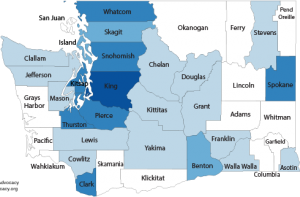Rural/urban health care divide
Rural areas have significant economic and geographic challenges, leading to significant resource disparities. Furthermore, rural populations pay a higher percentage of their income on out-of-pocket healthcare costs. Primary care is generally less available in rural areas, but the disparity is even more significant with regards to specialized, highly sophisticated, or high-intensity healthcare. Residents of rural areas are less likely to have employer-sponsored health insurance, and more likely to be on Medicaid.

Darker areas have more patients trying to see fewer providers.
Source: CMS market saturation and utilization data tool
Beyond the healthcare infrastructure, there are significant additional burdens borne by rural populations. Rural populations are more likely to be low income or unemployed. Rural residents are more reliant on public transportation, but transportation options are much lower: only 60% of rural counties nationwide have public transportation. Each of these issues has an effect on rural populations’ health outcomes, so residents experience higher rates of preventable conditions like obesity, diabetes, and cancer.
Rural/urban divide in applied behavior analysis
As a specialized health care service, applied behavior analysis can be difficult to come by in rural areas. Roughly one-third of Washington’s counties have no ABA providers – shown in white on the map below. One-third have a bare handful of BCBAs (light blues), and one-third have a significant number of BCBAs. On the other hand, King County, home to 30% of Washington’s population, has more ABA providers than the rest of the state combined.
ABA Providers by County

A primary complaint among Medicaid ABA providers is low reimbursement: For example, supervisors are required observe 5 percent of training, and while private insurance pays for the supervisor’s time, Medicaid pays $0. Where Medicaid does pay, rates are as low as 33 cents on the dollar compared to private insurance. Thus, even the largest insurance network in Washington has only 35 ABA clinics. As a result, at any given time almost 1,900 children with Medicaid are waiting for an opening to receive treatment.
In areas with denser populations, clinics can tailor their payor mix, accepting patients with high-paying private insurance and using those higher rates to offset losses associated with low Medicaid rates. However, if the service costs more to provide because Behavior Therapists spend more time driving, or there are fewer people with higher reimbursement, a clinic can afford to only accept a smaller percentage of Medicaid patients. When working with low-income families, some BCBAs try to provide enriching toys and educational materials to kids in need, but doing so adds another expense to the provider’s cost of services.
One proposed method of improving rural BCBA representation is expanding the University of Washington’s BCBA training program to their Spokane campus. Graduates frequently stay where they went to school, so an eastern Washington BCBA program should produce BCBAs who are more likely to practice east of the Cascades. Locally grown providers have other benefits, since they are familiar with the resources and needs of the area. Lastly, given the demand for BCBAs, there’s an economic benefit to easing the path to that area of employment for locals.
Takeaway
In urban areas, a child with private insurance might wait a month to receive ABA services, and a child with Medicaid will wait six to nine months. Rurally, the waitlists extend years, if services are available at all. Compounded by complex transportation issues, care is frequently placed completely out of reach. WAAA is working to improve the availability of ABA both rurally and for Medicaid patients. If this article resonates and you need assistance or to share your story, please reach out to WAAA via email or call the office at 425-894-7231.


